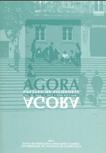¿Es posible el regreso de la belleza? Estética, belleza y política en el arte contemporáneo
Contenido principal del artículo
Resumen
Palabras clave:
Detalles del artículo
Referencias
Alberro, Alexander. “Beauty knows no pain”, Art journal 63(2004): 37-43. https://doi.org/10.2307/4134519
https://doi.org/10.1080/00043249.2004.10791124
Beckely, B. and Schapiro, D. (ed) Uncontrollable Beauty: Towards a New Aesthetics. New York: Allworth Press, Jeremy Gilbert-Rolfe, 1999.
Brady, Emily. The Sublime in Modern Philosophy: Aesthetics, Ethics, and Nature, Cambridge, Cambridge University Press, 2013. https://doi.org/10.1017/CBO9781139018098
Carrasco, Matilde. “De la estética de la forma a la estética del significado. Sobre el giro estético de A. Danto”, Revista de Filosofía, 38/1 (2013): 79-97. https://doi.org/10.5209/rev_resf.2013.v38.n1.41964
Costello, Diarmuid and Willsdon, Dominique (eds.) The life and Death of Images, New York: Cornell University Press, 2008.
Danto, Arthur C. “Embodied Meanings, Isotypes, and Aesthetical Ideas”, The Journal of Aesthetics and Art Criticism, 65/1 (2007): 121-129. https://doi.org/10.1111/j.1540-594X.2007.00243.x
Danto, Arthur C. “Intervention” in “The Art Seminar” in ed. James Elkins Art History Versus Aesthetics. New York; London: Routledge, 2006.
Danto, Arthur C. “Kalliphobia in Contemporary Art”, Art Journal, 63/ 2(2004): 24-35. https://doi.org/10.1080/00043249.2004.10791123
https://doi.org/10.2307/4134518
Danto, Arthur C. The Abuse of Beauty: Aesthetics and the Concept of Art. Chicago and LaSalle: Open Court, 2003.
Danto, Arthur C. Más allá de la caja brillo: las artes visuales desde la perspectiva posthistórica, Madrid: Akal, 2003.
Danto, Arthur C. “Beauty and Morality” en Beckley, B. and Schapiro, D. (ed) Uncontrollable Beauty, 1999, pp. 25-37.
Danto, Arthur C. “Art, Essence, History, and Beauty: A Reply to Carrier, a Response to Higgins”, The Journal of Aesthetics and Art Criticism, 54 (1996): 284-287. https://doi.org/10.2307/431631
Danto, Arthur C. “Bad Aesthetic Times”, en Encounters and Reflections: Art in the Historical Present Berkeley and Los Angeles: University of California Press, 1990, pp. 295-312.
Foster, Hal (ed.) The Anti-Aesthetic: Essays on Post-modern Culture. Washington: Bay Press, 1983.
Goldman, Alan H., “The Broad View of Aesthetic Experience”, The Journal of Aesthetics and Art Criticism, 71/ 4 (2013): 323-333.
Halsall, Francis, Jansen, Julia, and O'Connor, Tony (eds.) Rediscovering aesthetics: transdisciplinary voices from art history, philosophy, and art practice. Stanford Calif.: Stanford University Press, 2009.
Heinich, Nathalie. “Beyond Beauty: The Values of Art. Towards an Interdisciplinary Axiology” en Dorsch, Fabian and Ratiu, Dan-Eugen (eds.) Proceedings of the European Society for Aesthetics, 7 (2015): 259-263.
Heinich, Nathalie, Schaeffer, Jean-Marie, et Talon-Hugon, Carole (eds.) Par-delà le beau et le laid: les valeurs de l’art, Rennes: Presses Universitaires de Rennes, 2014.
Hickey, Dave. The invisible Dragon: Four Essays on Beauty. Art Issues, 1993.
Higgins, Kathleen Marie. “Whatever Happened to Beauty? A Response to Danto”, The Journal of Aesthetics and Art Criticism, 54 (1996): 281-284. https://doi.org/10.2307/431630
Jaar, Alfredo “Es difícil”, en Monegal, Antonio (comp.), Política y (po)ética de las imágenes de guerra, Barcelona, Paidós, 2007, pp. 203-211.
Jameson, Fredric. The Cultural Turn: Selected Writings on the Postmodern, 1988-1998. London: Verso, 1998.
Jimenez, Marc. La querella del arte contemporáneo, Buenos Aires: Amorrortu, 2010.
Kelly, Michael, A Hunger for Aesthetics: Enacting the Demands of Art. New York: Columbia U.P, 2012.
https://doi.org/10.7312/kell15292
https://doi.org/10.7312/columbia/9780231152921.001.0001
Kelly, Michael. “The Richter Effect on the Regeneration of Aesthetics”, en Halsall, Jansen, y O'Connor (eds.) Rediscovering aesthetics, 2009, pp. 256-273.
Korsmeyer, Carolyn. “What Beauty Promises: Reflections on Alexander Nehamas, Only a Promise of Happiness: The Place of Beauty in a World of Art”, British Journal of Aesthetics 50 (2010): 193-198. https://doi.org/10.1093/aesthj/ayq002
Korsmeyer, Carolyn. Savoring Disgust: The Foul and the Fair in Aesthetics, New York, Oxford University Press, 2010.
McFee, Graham. Artistic Judgement. A Framework for Philosophical Aesthetics. London: Springer, 2011. https://doi.org/10.1007/978-94-007-0031-4
Mothersill, Mary. Beauty Restored. Oxford: Clarendon Press, 1986.
Meyer, James and Ross, Toni. “Aesthetic/Anti-Aesthetic: An Introduction”. Art Journal, 63/ 2 (2004): pp. 20-23.
https://doi.org/10.1080/00043249.2004.10791122
https://doi.org/10.2307/4134517
Michaud, Ives. El arte en estado gaseoso. México: FCE, 2007.
Michaud, Ives. El juicio estético. Barcelona: Idea Books, 2002.
Nehamas, Alexander. “Reply to Korsmeyer and Gaut”, British Journal of Aesthetics 50 (2010): 205-207. https://doi.org/10.1093/aesthj/ayq004
Nehamas, Alexander. Only a Promise of Happiness. The Place of Beauty in a World of Art. Princeton and Oxford: Princeton University Press, 2007.
Osborne, Peter. “Art beyond Aesthetics: Philosophical Criticism, Art History and Contemporary Art”, Art History, 27/ 4 (2004): 651- 670. https://doi.org/10.1111/j.0141-6790.2004.444_9_9.x
https://doi.org/10.1111/j.0141-6790.2004.00442.x
Ramírez, J.F., Tobón, D. J. y Venegas, C. (eds.), ¿Arte sin estética? Universidad de Antioquía: Medellín, 2016.
Scarry, Elaine. On Beauty and Being Just, orig. pub.1999, London: Duckbacks, 2001.
Scruton, Roger. Beauty. Oxford University Press, 2011.
Seel, M. “Art as Appearance: Two Comments on Arthur C. Danto’s After the end of Art”, History and Theory, 37/4 (1998): 102-114. https://doi.org/10.1111/0018-2656.701998070
Shiner, Larry. La invención del arte, Barcelona, Paidós, 2004.
Sibley, Frank. “Aesthetic Concepts”, The Philosophical Review, 68 (1959): 421-450. https://doi.org/10.2307/2182490
Steiner, Wendy. Venus in exile: The rejection of beauty in Twentieth Century Art. NY: The Free Press 2001.
Tafalla, Marta. “Por una estética de la naturaleza: la belleza natural como argumento ecologista”, Isegoría, 32 (2005): 215-226. https://doi.org/10.3989/isegoria.2005.i32.445
Vilar, Gerard. “Antiestética y arte contemporáneo”, en J.F. Ramírez, D. Jerónimo Tobón y C. Venegas (eds.), ¿Arte sin estética?, 2016, pp. 1-20.
Vilar, Gerard. “Ética y Estética” en Pérez Carreño, F. (ed.) Estética, Madrid: Tecnos, 2013, pp. 237-260.
Vilar, Gerard. Desartización. Paradojas del Arte sin Fin, Salamanca: Universidad de Salamanca, 2010.
Vilar, Gerard. “Adorno: Una Estética Negativa” en Valeriano Bozal (ed.) Historia de las Ideas Estéticas y Teorías Artísticas Contemporáneas vol. II, Madrid: Antonio Machado, 1999, pp. 208-212.






